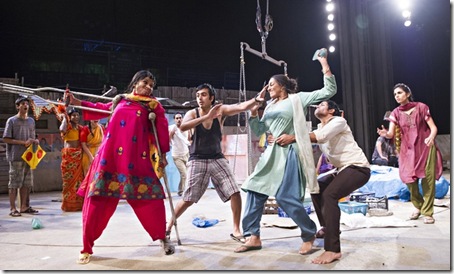Behind the Beautiful Forevers.
Photo. Tristram Kenton/Guardian.
Recent films in Ottawa have shown us radically different perspectives of India and the contrast is astonishing for those of us who do not know the country. The beautiful film The Second Best Exotic Marigold Hotel, the sequel to the film The Best exotic Marigold Hotel shows us upwardly mobile Hindu families, property owners who are working with the British Elderly and Beautiful who join the locals in Jaipur to renovate a hotel in ruins while preparing a sumptuous wedding ceremony that ends in lavish fireworks and Bollywood style dancing A feel good movie that shows Indian upper middle classes from a British perspective where everyone goes home happy.
This new live performance Behind the Beautiful Forevers , brought in by satellite, the first ever National Theatre production with an all British-Asian cast says director Rufus Norris proudly, shows us a very different India and it was a lot less pleasant.
Based on Katherine Boos Pulitzer Prize-winning study of poverty in the Annawadi Slum near the Mumbai Airport, David Hare’s play under the very skillful direction of Rufus Norris, becomes a powerful portrait of life in the slum that rises far beyond the local or exoticized images of feuding families and devastating poverty meant for the eyes of a western audience. The play could be called “verbatim” theatre as Norris suggests because it retains much of the actual dialogue recorded by Boo and published in her book. Hare weaves together a series of short sketches that evoke a brechtian episodic structure, building up little by little the conflicts , with moments of good parody, that underlie the lives of these many families, squashed together under bits of cardboard and metal left overs, clay bricks and parts of buildings, all slapped together in Katrina Lindsay’s set to create the sense of a fragile community of individuals whose relationships could explode into violence at any second. They all survive by sorting, picking and transporting garbage that is tossed from the airplanes or gathered by the river, the play turns into a tragedy, the result of an almost funny local skirmish between Fatimah the one-legged woman and Zehrunisa, the matriarch of the Husain family who has managed her money well enough to be able to rebuild her house. The conflict then centres around two Moslem families who are uneasy neighbours. On this very effective revolving set where the beat of the Hindu music accompanies the movements of the young men running around gathering garbage , packing their pickings , it brings in a physical form of excitement to the stage that echos a less flashy style of an Indian Dance-drama.
This marginalized slum becomes a microcosm of a condemned society whose inhabitants, no matter how honourable they are, are caught in a deadly trap of corruption, greed, social inequality, ignorance, violence, prejudice. Those in charge as well as those with no power are in fact all victims of a system that not only preys on the poor for their money but that also transforms the poor into scape goats. Those in power need to beat them and mistreat them to relieve their own frustrations, thus, this world reflected by David Hare becomes unbearably cruel because they are all helpless victims of the situation, no matter how hard they struggle.
Different twists in the story suggest various possible resolutions , some are sad, some are more ambiguous but they all give us a sense that very little can ever change , even though the playwright seems to be trying to avoid leaving the audience in total despair. And yet, this is an engaging drama built around a politically relevant question and the result is excellent political theatre. We are not only fascinated by the theatrical event but mesmerized and disturbed by the way the author has represented the lives of individuals caught in a world financial spiral over which they have no power ad which they cannot understand.
This strong cast of young and older actors all hold their own beautifully. Powerful women represented by Stephanie Street, Meera Syal, Thusita Jayasundera, dominate the stage but the younger daughters – Meena played by Anneika Rose , and Manju played by Anjana Vasa – are also extremely moving and they take charge of their roles and their characters. Unforgettable is the literature lesson in the latrine where Manju, studying Virginia Woolf’s Mrs Dalloway explains to the illiterate Meena why the book means nothing to her even though it becomes a serious clue , telling us that depression and suicide are not far off. There is also the the thoughtful and devoted son Abdul (Sarataj Garewal) , as well as the playful and ambitious Sunil (Hiran Abeysekera) who brought in all the energy of the young with the “Mumbai moves” along with the ill-fated Kalu (Assad Zaman) and several others in the cast who appear to be professional dancers. The staging does include a form of slick choreography which captures the theatrical beat of the slum life and makes the pulse beat faster .
Remarks on the part of some audience members suggested that they had some difficulty with the Indian accents but I had none at all.
As an exciting and disturbing experience, Behind the Beautiful Foerevers is a curious combination of moments that give one a physical jolt, and then translate into a truly remarkable and undeniably contemporary piece of political theatre.
Coming soon to Cine plex theatres. April 18, 2015 in all Cineplex Theatres
Behind the Beautiful Forevers
By David Hare based on the Pulitzer Prize-winning book of nonfiction by Katherine Boo.
Directed by Rufus Norris
by David Hare
Based on the book by Katharine Boo
Directed by Rufus Norris
A production of the National Theatre in London
